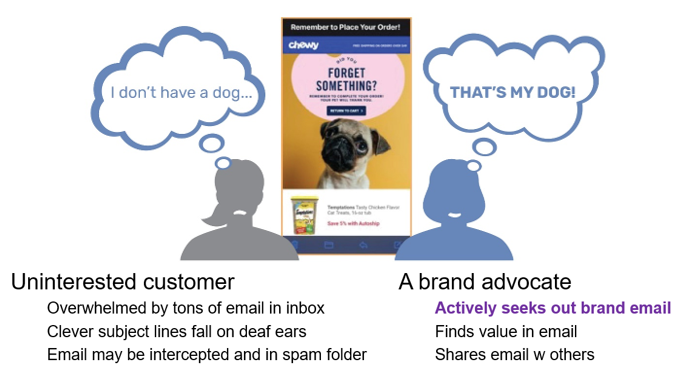Technology leaders want a strong Marketing partner. They look to Marketing to be articulate, visionary; to build a consensus. They want Marketing leaders to define success and measure business outcomes. But are we- as Marketing leaders - up to the task?
There is a lot at stake. Without Marketing leadership, IT runs the risk of over scoping a solution or missing critical requirements (and under scoping). Either way that means trouble:
- Wasted technology that doesn’t get used
- Wasted effort to integrate and maintain yet another tool
- Too many vendors to manage
- Difficulty proving the value
- Marketing not using the solution
- Difficulty in data management (without direction)
- Not future-proofing the tech for the long run
So Marketing leaders: this is our chance. To rise to the challenge. To be good partners to IT.
Let's get something out of the way first: don’t accept that you are not technical. Nobody expects you to write code. So whether you are envisioning a full blown Customer Data Platform (CDP) or any component of Marketing Technology (MarTech), take this as your opportunity to:
- Lead the Discovery process. Document stakeholder needs. Ask questions like – “what do you wish you had?” “what would you be able to do if you had it?” Summarize the answers; add value, focus on business decisions you could make, customer experiences you could improve, etc.
- Perform a gap analysis. Identify the gap between current state and ideal state. Be strategic and don’t prescribe technology as the magic solution. Articulate why closing a gap will solve a business problem and be honest – some gaps relate to maturity, capabilities, skillsets, culture. Remember you will share a vision of the future and will need to build a consensus. Using a maturity model, a way to assess your progress, is your chance to lead.
- Set priorities. What kind of impact is technology going to bring the firm? How much effort will be required (rough estimate – low, medium, high). Put this on a quadrant to chart those high impact and lower effort items, and reveal the “low hanging fruit” so you can gain momentum.
- Develop a roadmap . Recommend a course of action – a mixture of quick wins and big steps forward. Consider a “crawl” “walk” “run” methodology to share the vision:

- Prove the value. Document use cases for how MarTech will add incremental value and deliver business outcomes. The best use cases are scenarios for success; another chance to share your vision. Where will the benefit come from in detail?
- Write a business case. Marketing leaders should summarize use cases into a business case. They think of Marketing Technology as an investment, not a cost. What kind of Return on Marketing Investment (RoMI) do you expect? How long will it take to pay back? What are the total costs?
When Marketing leaders go through all these steps, they commit to being accountable. This goes a long way, whether assumptions turn out to be right or wrong. So do the work and have the courage to adjust as you learn.
Modern Marketing can’t exist without Technology
In this YouTube video, Forrester Research boils MarTech down to its critical capabilities that create great customer experiences:
- Customer recognition (which includes assignment to Personas)
- Customer insights (which includes predictions of future behaviors)
- Speed (as in realtime)
- Seamless experiences across channels
- Continuous delivery of personalized experiences
Who owns what? What does Marketing own? What does Tech own? Ownership is another chance to collaborate. In the case of customer recognition, Tech leaders might argue they own Master Data Management (MDM), Customer Data Integration (CDI) or a “golden record” process for reconciling customer identity. And they’re right; but Marketing leaders have a part to play.
Marketing leaders are responsible for customer strategy – a balancing act between acquisition and retention investments. This is as much vision as it is technology. If Marketing wants to invest in a Customer Data Platform, what are capabilities beyond the Data Warehouse (hint: identifying and marketing to anonymous visitors). Then, what is the incremental value to justify the extra investment? How do the data integrate back into the EDW and improve what Tech has built?
So you can see, both Marketing and Tech own the solution. In other words, don't fight over responsibilities, collaborate and get more accomplished.

Six ways Marketing leaders can collaborate with Tech
If you ask industry expert Valerie Skeese how Marketing and Tech leaders can collaborate, she will tell you six things Marketing leaders can do:
- Engage IT early when evaluating new or changing tools and applications. The last thing you want to deal with is a barrier in the final stretch of a tool or vendor selection to realize there may be security or architecture considerations you weren’t aware of.
- Establish a regular meeting cadence for information sharing both from a business and IT perspective. Understanding what’s critical to the business outside of marketing can help in realistically prioritizing as well as help craft the story around initiatives marketing is trying to drive that may complement other areas.
- Share your pain points. Sometimes lack of action is just a lack of awareness or complete understanding of the problem. For example, if data availability is an issue in your organization, articulate how it impacts the team or your customer. “My marketing operations team has difficulty when data isn’t available at the beginning of the business day because it affects our deliverables to our email service provider. When an email for a limited time flash sale is delivered late, it causes frustration for the customer, increased contacts to customer service and lost revenue.”
- Help your IT partners understand the why…“When data isn’t available real-time, we lose the ability to act on a new customer sign-up by sending a welcome email when they are most engaged.”
- Embrace trial subscriptions for tools, proof of concepts or pilots to fail fast. Is there a limited use case you can focus on to understand the features and flaws of a tool minimizing the amount of effort up front from both IT and marketing to ensure this will meet marketing needs?
- Provide ongoing feedback on changing privacy impacts resulting from both regulation and third parties. This is to ensure IT is educated on upcoming changes and the rationale behind them when we suddenly ask for support for a new Facebook Conversion API or to change email performance reporting metrics due to Apple iOS privacy changes.
The rewards for collaboration include Marketing using the solutions, embracing the tools, becoming self sufficient, and extracting value from Tech.
When Marketing owns customer strategy and customer experience, Technology welcomes Marketing’s leadership. In return, the best Marketing leaders support Tech leaders and demonstrate how tech investments solve business problems and proves the value of MarTech investments. And that’s the way – uh huh, uh huh – Tech likes it.
 Valerie Skeese is Vice President of Customer Data Management at Victoria's Secret. Valerie specializes in leading teams responsible for Customer Data, Campaign Execution, and Customer Analytics. Passionate about data, identity resolution and MarTech, Valerie's focus is customer data strategy and management for marketing, personalization, data science and analytics applications.
Valerie Skeese is Vice President of Customer Data Management at Victoria's Secret. Valerie specializes in leading teams responsible for Customer Data, Campaign Execution, and Customer Analytics. Passionate about data, identity resolution and MarTech, Valerie's focus is customer data strategy and management for marketing, personalization, data science and analytics applications.




